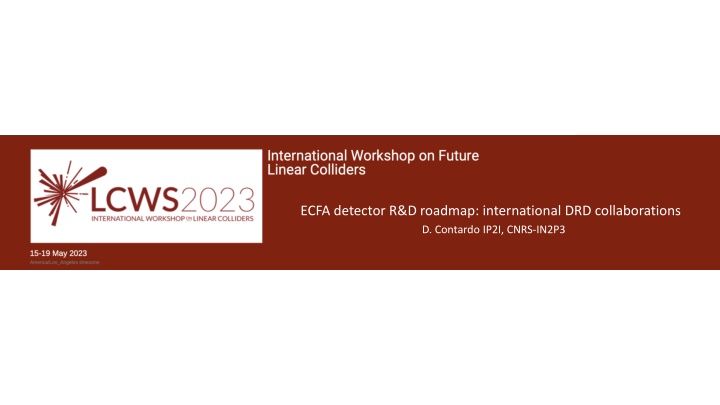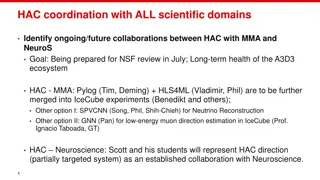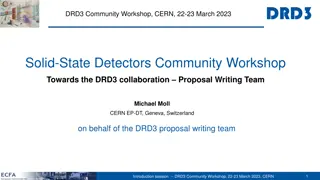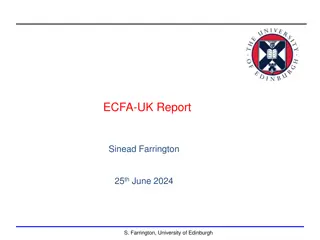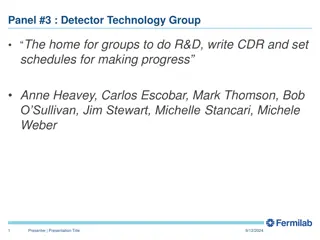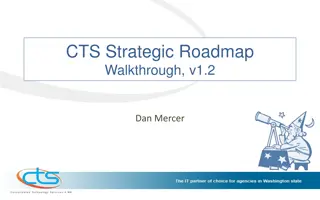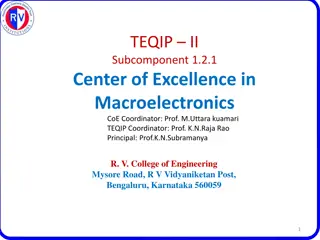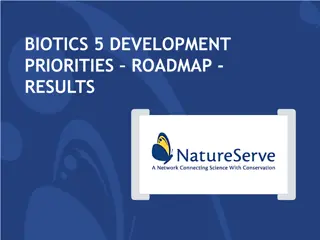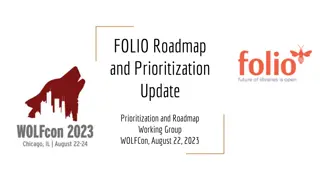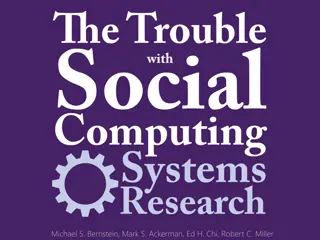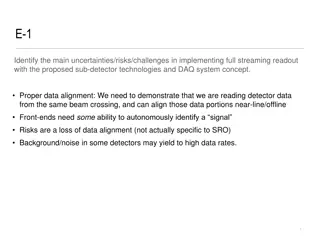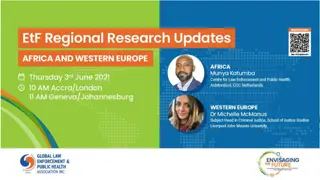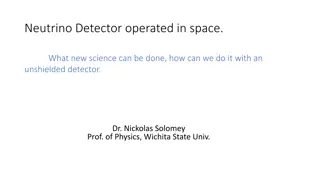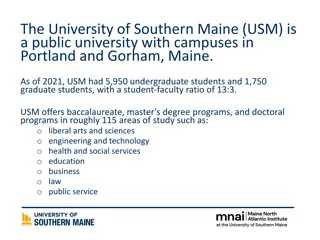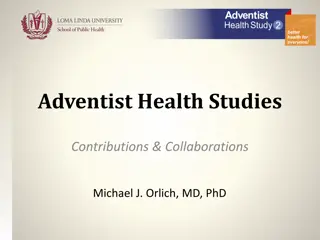ECFA Detector R&D Roadmap and International Collaborations Update
The ECFA Detector R&D Roadmap outlines collaborative efforts in particle physics research, focusing on high-field magnets, muon beams, and more. Task Forces are coordinating community consultations for future experimental programs, with a goal to fulfill strategic needs identified by the ESPP update. The roadmap aims to enhance detector systems and technology options for various experiments, including those at large accelerator facilities and small accelerators. The presentation highlights the importance of future collider planning and construction in the field of physics.
Download Presentation

Please find below an Image/Link to download the presentation.
The content on the website is provided AS IS for your information and personal use only. It may not be sold, licensed, or shared on other websites without obtaining consent from the author.If you encounter any issues during the download, it is possible that the publisher has removed the file from their server.
You are allowed to download the files provided on this website for personal or commercial use, subject to the condition that they are used lawfully. All files are the property of their respective owners.
The content on the website is provided AS IS for your information and personal use only. It may not be sold, licensed, or shared on other websites without obtaining consent from the author.
E N D
Presentation Transcript
ECFA detector R&D roadmap: international DRD collaborations D. Contardo IP2I, CNRS-IN2P3
2020 Update of the European Strategy for Particle Physics Physics under LDG, coordination formed 2021 Accelerator R&D roadmap High-Field Magnets - Radiofrequency Structures - Muon Beams - Energy Recovery Linacs - Plasma Acceleration (Physics Briefing Book) 2023 DRD collaboration proposals 2021Detector R&D roadmap under ECFA, on-going this talk US process : 2022 Snowmass symposium briefing book, P5 strategy update autumn 2023 2
ECFA detector R&D roadmap preparation 9 Task Forces organizing wide consultation of the community* through questionnaires and symposia** 3 transverse areas 6 areas mapping technologies, detector systems and strategic programs * Nuclear Physics and AstroParticle (including Gravitational Wave) not considered in the roadmap, but NuPPEC and ApPEC invited to follow the process, also joint ECFA - NuPECC - ApPEC seminars in 2019 - 2022 to develop common instrumental projects ** great source of information on requirements for future experimental programs and State or the Art detector R&D, also US CPAD workshop 2022 4
ECFA detector R&D roadmap goal establish needs to fulfil strategic programs identified by the ESPP update future experiments at large accelerator facilities future experiments at small accelerators, at nuclear reactors and/or with cosmic rays Dark Matter, Neutrino, 0? mostly related to TF2 liquid detectors and TF5 quantum and emerging sensors 3
ECFA detector R&D roadmap goal establish needs to fulfil strategic programs identified by the ESPP update focus of this presentation future collider planning pr paration construction - physics - ee, hh, 3
ECFA detector R&D content Front view of the CMS detector barrel part ball park performance targets detector R&D Themes needs/benefits for physics reach Systems and technology options ex. TF3 Solid State Detector 10 General Recommendations to achieve outlined goals, two about execution GR4: international coordination and organization of R&D activities ensure red dots are fulfilled and orange achieved to the best by the program need-dates GR6: establish long term strategic funding program 5
Proposal to implement the roadmap GR4 and GR6 approved by CERN Council Sep. 2022 form DRD international collaborations anchored at CERN with a status similar to experiments: DRDC scientific review committee*, Funding Agency MoU agreements, Resources Review Board EDP hosted at DESY : interface to experiments, vetting scope, goals & milestones, acting as expert members in DRDC DRDC being formed TFx/DRDx are areas identified by the roadmap a coordination panel for training (TF9/DRD9) DRD proposals to DRDC end-July 2023**, collaborations active Jan. 2024, MoUs prepared/signed by FAs in 2024 * Review frequency will de defined by the DRDC, it could typically be every 2 years ** TF7/DRD7 and TF5/DRD5 only LoI in July, full proposal end-2023 /beginning 2024, TF8/DRD8 possibly a forum under discussion 6
Timeline considerations for DRD planning when technical solutions must be handled to strategic projects* DRD collaborations active Jan. 2024 Physics start Blue sky low Technology Readines Level continuous R&D process Experiment design & system engineering Production and installation DRD strategic R&D 12 years 2037 2048 3 + 6 + 3 years CLIC/FCC-ee Muon Coll. 4 - 5 years 3 + 6 + 3 years 2028 2040 ILC/CCC 3 - 4 years 2027 2035 7 - 8 years ALICE-3, LHCb-2, ATLAS/CMS, EIC, BELLE-3, stepping stones and also CEPC current planning 7 * ballpark timelines for future colliders, smaller scale projects mostly upgrades of existing experiments with fixed LS4 timeline for HL-LHC
Topical considerations to establish DRD planning interplay between DRDs * direct the community contributions to Work Packages and resources in proper DRD(s) 7 * LNF - Italy, STFC/Daresbury - UK, CIEMAT - DESY, Germany, STFC/RAL - UK , LNGS - Italy, F.CEA/Irfu France, IJCLab France, Nikhef - Netherlands, PSI - Switzerland
DRD proposals scientific content transverse activities planning simulation/characterization tools, beam test facilities, industrial partnership, dissemination & networking technology Work Packages planning deliverables - milestones Work Packages & technology options not contractual ex. Monolithic CMOS DRD3.1 1st period typically 3-4 years targeting stepping stone programs (slide 8) previsions toward longer term strategic projects programs will evolve* with experiment requirements & R&D progress including blue sky growing TRL 7 * In relation with review process cycles
DRD proposals resources and organization structure content demonstrate programs can reasonably be achieved Public documents will contain: list of institutes willing to contribute to each WP scale of human and funding resources required to achieve each WP management, committees and working group organization Confidential material on resources in support of programs will be submitted to the DRDC sum of resources (HR and funding) currently expected to be available sum of new strategic resources sought initial money matrix of contributions per Funding Agency It is expected that institutes will have entered into negotiations with their Funding Agency to ensure that the assumptions on additional strategic support can be considered (although not guaranteed before MoU 1st agreements*) * it is foreseen that MoUs will be regularly updated as the R&D programs evolve (with a frequency to be agreed between CERN and FAs) 7
DRD collaboration proposal preparation under ECFA roadmap panel (slide 3), with TF experts and existing program conveners* TF1/DRD1 Gaseous Detectors https://indico.cern.ch/event/1214405/ TF2/DRD2 Liquid Detectors https://indico.cern.ch/event/1214404/ TF3/DRD3 Solid State Detectors https://indico.cern.ch/event/1214410/ TF4/DRD4 Photon Detectors and PID https://indico.cern.ch/event/1214407/ TF5/DRD5 Quantum and Emerging Technologies https://indico.cern.ch/event/1214411/ TF6/DRD6 Calorimetry https://indico.cern.ch/event/1213733/ TF7/DRD7 Electronics and On-detector Processing https://indico.cern.ch/event/1214423/ TF8/DRD8 Integration https://indico.cern.ch/event/1214428/ TF9/DRD9 Training https://indico.cern.ch/event/1214429/ Wide consultation with the community**, workshops & surveys to establish program & contributions * ex. current CERN RD which mandate end end-2023 and will become part of the new wider scope DRD collaborations: RD51 (MPGDs) in TF1/DRD1, RD50 (radiation hard semiconductors) & RD42 (diamond) in TF3/DRD3, RD18 (crystals) in TF4/DRD4 and TF6/DRD6 ** Subscription to follow the process and to contribute at the links 7
DRD1 Gaseous Detectors program & community building status conveners: Anna Colaleo, Leszek Ropelewski, 292 people registered Organized in 8 working groups to develop the R&D program WG1 : technologies MPGDs, RPC, Wires, TPC, DCH WG2 : applications muon tracking and triggering, Central Tracking with PID, Photon Detection, ToF, High Granularity Calorimetry, TPC for rare event searches WG3 : gas and material studies WG5 : electronic components WG6 : detector production WG7 : common test facilities WG8 : training and dissemination Detailed survey in each WG to assess community interests 74 contributions presented at 1st community meeting Geographical distribution Planning of technology Work Packages (deliverable/milestones) on-going mapping of needs and aspirations of the community Discussion of collaboration structure on-going proper arrangement of technology and transverse activities DRD1 proposal draft at 2nd community meeting 6 Colors indicative of Technology areas versus transverse activities
DRD3 Solid State Detectors program & community building status conveners: Nicolo Cartiglia, Giulio Pellegrini, 484 people registered Organized in 8 working groups to develop the R&D program WG1 : Monolithic CMOS sensors WG2 : sensors for tracking and calorimetry (Hybrid, LGADs) WG3 : radiation damage and ultrahigh fluence WG5 : characterization techniques, facilities WG6 : non silicon based detectors WG7 : Interconnect and device fabrication WG8 : dissemination and outreach Survey to assess community interests 88 contributions presented at 1st community meeting Planning of technology Work Packages (deliverable/milestones) on-going mapping of needs and aspirations of the community Predominance of CMOS(MAPS) Geographical distribution DRD3 proposal draft beginning of June 6
DRD4 Photon Detectors and PID program & community building status conveners: Peter Krizan, Christian Joram, 217 people registered 4 Technology areas identified in coordination meeting WG1 : photodetector (SiPM, SPADs, PMT/MCP-PMT, Gas) WG2 : particle ID (RICH/DIRC/TOP,TORCH/ToF) WG3 : technologies (radiators, optical elements, readout, cooling, software) WG4 : emerging technologies (novel materials and concepts ) Survey to assess community interests 40 contributions Planning of technology Work Packages (deliverable/milestones) 1st community meeting this week 16 17 May WG2 DRD4 proposal draft end-June WG1 6
DRD6 Calorimetry program & community building status conveners: Roberto Ferrari, Roman P schl, 232 people registered Organized in 4 working groups to develop the R&D program (1st community meeting) WG1 : full integrated sampling calorimeters WG2 : liquified Noble Gas calorimeters WG3 : optical calorimeters WG4 : transverse activities Institutes per proposal WG2 WG3 WG1 WG4 Survey to assess community interests 23 contributions, 110 institutes, presented at 2nd community meeting Planning of technology Work Packages (deliverable/milestones) on-going mapping of needs and aspirations of the community DRD6 proposal draft beginning of June Institutes per country 6
DRD7 electronics and on-detector processing program & community building status conveners: Francois Vasey, Dave Newbold, 183 people registered Technology areas identified at 1st community workshop WG1 : data density and power efficiency WG2 : intelligence on the detector WG3 : 4D and 5D techniques WG4 : extreme environments WG5 : backend systems and cots WG6 : complex imaging ASICs and technologies WG7 : provision access to tools and technologies (vendors) organization proposal Interaction with other DRDs DRDs provide specification, planning, production and characterisation of prototypes with relevant RH and funding DRD7 review specifications and designs, develop and provision common IP, components, and subsystems, deliver common, generic, complete components / systems, when big or complex Work organisation proposal being investigated Tiered/platform structure of competences (with appropriate sharing of human resources with other DRDs) Next steps May-June collect expressions of interest in specific projects, define common plans and interface to other DRDs July DRD7 LoI indicating broad scope, composition and resource needs scale September 2nd community workshop to discuss Work Packages December proposal submitted to DRDC including resources 6
DRD2 Liquid Detectors program & community building status conveners: Roxanne Guenette, Jocelyn Rebecca Monroe, Ian Shipsey, 168 people registered Technology areas identified in coordination meeting WG1 : charge readout WG2 : light readout WG3 : target properties WG4 : scaling-up WG1 WG2 WG3 WG4 Planning of technology Work Packages 1st community meeting WPs Survey to assess community interests and WP deliverables/milestones on-going DRD2 proposal draft early-June 6
DRD5 Quantum and emerging technologies program & community building status conveners: Michael Doser, Marcel Demarteau, Ian Shipsey, 164 people registered Proposal to organize WGs define in expert workshop Apr. WG1 : clocks, clock networks WG2 : kinetic detector WG3 : superconducting spin based sensors WG4 : optomechanical sensors WG5 : atoms, molecules, ions, interferometry WG6 : meta materials 0-1-2D materials Next steps circulate minutes of workshop with seeds of Work Package circulate white paper to organise WGs July submit LoI to DRDC with initial projects and resource needs scale September 1st community meeting to tune WP proposal January 2024 submit proposal to DRDC 6
Summary Forming DRD collaborations raises strong international interest it is a good time to join Establishing first stage of R&D programs is well underway These programs will have dynamic evolution integrating new ideas while handling solutions to strategic programs Positive feedback from FAs was received through rECFA DRD programs will value investments with potential to ramp-up resources 6
Overall process and timeline to form the DRD collaborations* 7 * Presentation of K. Jakobs at the SPSC on Sept. 27, 2022 (private communication)
Plans for training (TF9) 12 * Presentation of K. Jakobs (ECFA Chair) at the SPSC on Sept. 27, 2022 (private communication)
Further references DOE Basic Research Needs Study on High Energy Physics CERN EP R&D program AIDAINNOVA European Program (linking research infrastructures in detector development and testing) Attract European Program (linking to industry on detection and imaging technologies) ECFA EDP documents (input to ESPP, community survey ) 12
